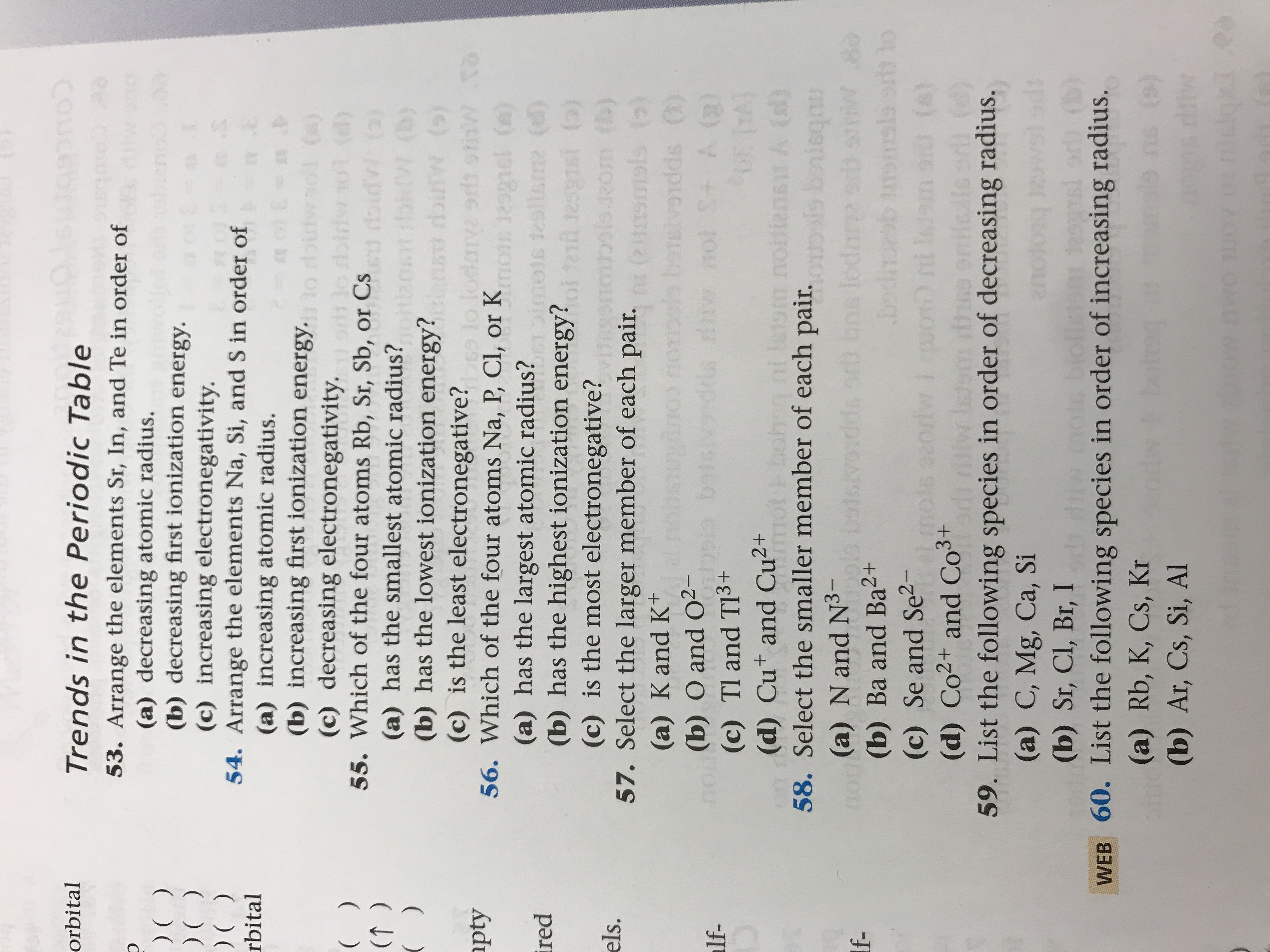
Chemistry
10th Edition
ISBN: 9781305957404
Author: Steven S. Zumdahl, Susan A. Zumdahl, Donald J. DeCoste
Publisher: Cengage Learning
expand_more
expand_more
format_list_bulleted
Question

Transcribed Image Text:**Trends in the Periodic Table**
53. Arrange the elements Sr, In, and Te in order of
(a) decreasing atomic radius.
(b) decreasing first ionization energy.
(c) increasing electronegativity.
54. Arrange the elements Na, Si, and S in order of
(a) increasing atomic radius.
(b) increasing first ionization energy.
(c) decreasing electronegativity.
55. Which of the four atoms Rb, Sr, Sb, or Cs
(a) has the smallest atomic radius?
(b) has the lowest ionization energy?
(c) is the least electronegative?
56. Which of the four atoms Na, P, Cl, or K
(a) has the largest atomic radius?
(b) has the highest ionization energy?
(c) is the most electronegative?
57. Select the larger member of each pair.
(a) K and K⁺
(b) O and O²⁻
(c) Tl and Tl³⁺
(d) Cu⁺ and Cu²⁺
58. Select the smaller member of each pair.
(a) N and N³⁻
(b) Ba and Ba²⁺
(c) Se and Se²⁻
(d) Co²⁺ and Co³⁺
59. List the following species in order of decreasing radius.
(a) C, Mg, Ca, Si
(b) Sr, Cl, Br, I
60. List the following species in order of increasing radius.
(a) Rb, K, Cs, Kr
(b) Ar, Cs, Si, Al
Expert Solution
arrow_forward
Step 1
Hello. Since your question has multiple parts, we will solve the first question for you. If you want the remaining parts to be solved, then please resubmit the whole question and specify those parts you want us to solve.
Step by stepSolved in 2 steps

Knowledge Booster
Recommended textbooks for you
 ChemistryChemistryISBN:9781305957404Author:Steven S. Zumdahl, Susan A. Zumdahl, Donald J. DeCostePublisher:Cengage Learning
ChemistryChemistryISBN:9781305957404Author:Steven S. Zumdahl, Susan A. Zumdahl, Donald J. DeCostePublisher:Cengage Learning ChemistryChemistryISBN:9781259911156Author:Raymond Chang Dr., Jason Overby ProfessorPublisher:McGraw-Hill Education
ChemistryChemistryISBN:9781259911156Author:Raymond Chang Dr., Jason Overby ProfessorPublisher:McGraw-Hill Education Principles of Instrumental AnalysisChemistryISBN:9781305577213Author:Douglas A. Skoog, F. James Holler, Stanley R. CrouchPublisher:Cengage Learning
Principles of Instrumental AnalysisChemistryISBN:9781305577213Author:Douglas A. Skoog, F. James Holler, Stanley R. CrouchPublisher:Cengage Learning Organic ChemistryChemistryISBN:9780078021558Author:Janice Gorzynski Smith Dr.Publisher:McGraw-Hill Education
Organic ChemistryChemistryISBN:9780078021558Author:Janice Gorzynski Smith Dr.Publisher:McGraw-Hill Education Chemistry: Principles and ReactionsChemistryISBN:9781305079373Author:William L. Masterton, Cecile N. HurleyPublisher:Cengage Learning
Chemistry: Principles and ReactionsChemistryISBN:9781305079373Author:William L. Masterton, Cecile N. HurleyPublisher:Cengage Learning Elementary Principles of Chemical Processes, Bind...ChemistryISBN:9781118431221Author:Richard M. Felder, Ronald W. Rousseau, Lisa G. BullardPublisher:WILEY
Elementary Principles of Chemical Processes, Bind...ChemistryISBN:9781118431221Author:Richard M. Felder, Ronald W. Rousseau, Lisa G. BullardPublisher:WILEY

Chemistry
Chemistry
ISBN:9781305957404
Author:Steven S. Zumdahl, Susan A. Zumdahl, Donald J. DeCoste
Publisher:Cengage Learning

Chemistry
Chemistry
ISBN:9781259911156
Author:Raymond Chang Dr., Jason Overby Professor
Publisher:McGraw-Hill Education

Principles of Instrumental Analysis
Chemistry
ISBN:9781305577213
Author:Douglas A. Skoog, F. James Holler, Stanley R. Crouch
Publisher:Cengage Learning

Organic Chemistry
Chemistry
ISBN:9780078021558
Author:Janice Gorzynski Smith Dr.
Publisher:McGraw-Hill Education

Chemistry: Principles and Reactions
Chemistry
ISBN:9781305079373
Author:William L. Masterton, Cecile N. Hurley
Publisher:Cengage Learning

Elementary Principles of Chemical Processes, Bind...
Chemistry
ISBN:9781118431221
Author:Richard M. Felder, Ronald W. Rousseau, Lisa G. Bullard
Publisher:WILEY